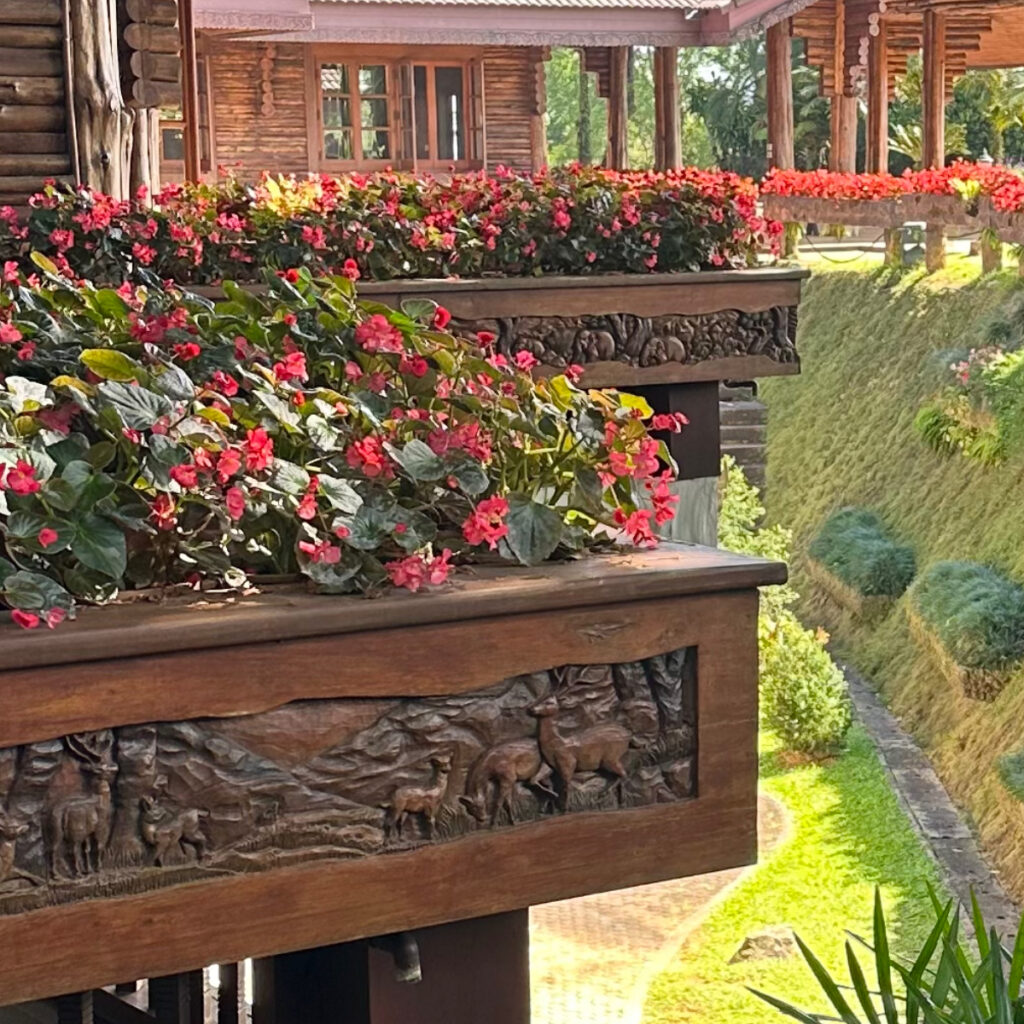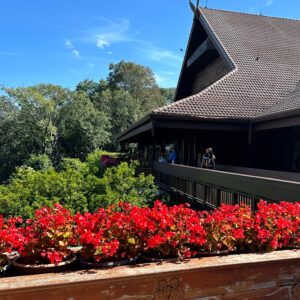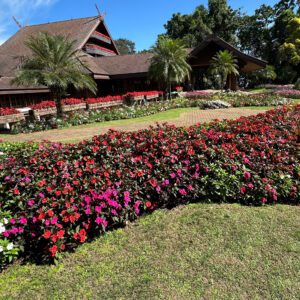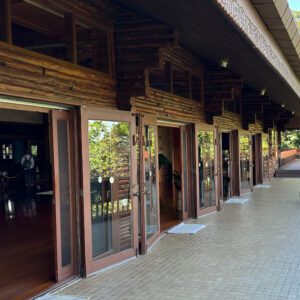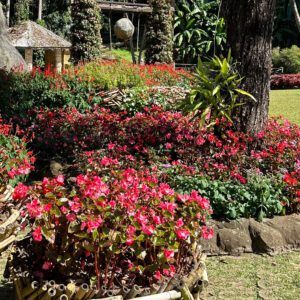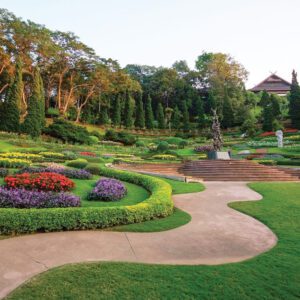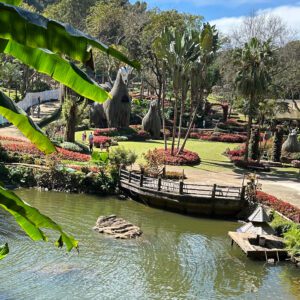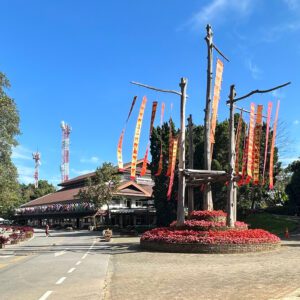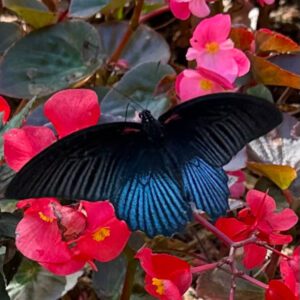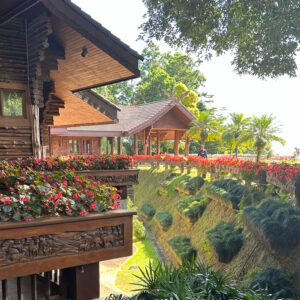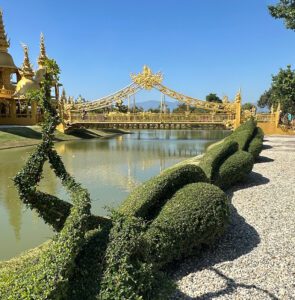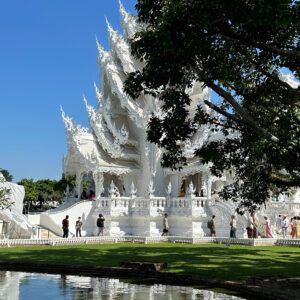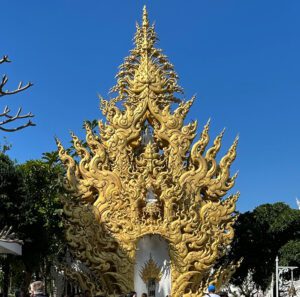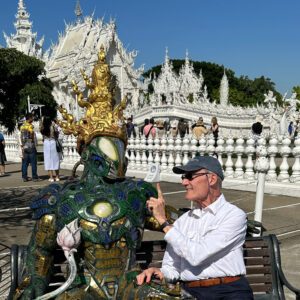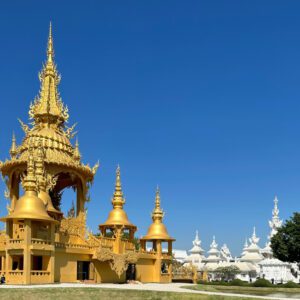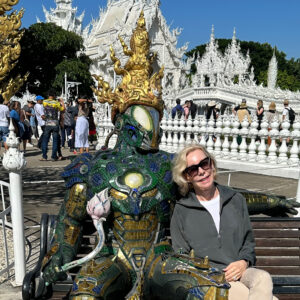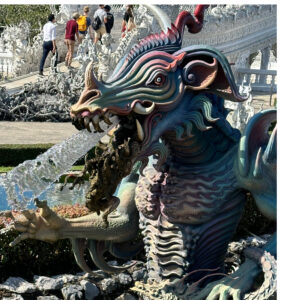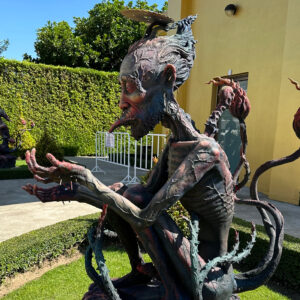Exploring Chiang Rai Province
Thailand is a fascinating country. This is one of our favorite places to travel in Southeast Asia primarily due to the friendliness of the people and the safety of travel. If you are planning to travel after retirement all the better. You can spend as much time as you would like, budget permitting. Spending a week at the Elephant Camp was the highlight for us in Chiang Rai Province. That encouraged us to learn more about the Thai culture and history because of the hospitality extended to us.
To help us better understand the culture we found two other notable landmarks in Chiang Rai Province that sounded interesting; Doi Tung Royal Villa and the White Temple. We secured transportation and headed out. Each site was about one hour travel by car from the Elephant Camp.
Doi Tung Royal Villa of Thailand
Doi Tung Royal Villa holds a rich and historical significance dating back to the late 1980’s. Steeped in tradition and cultural heritage, the villa is a beautiful, architectural marvel. It has become a symbol of Princess Srinagarindra‘s dedication to the preservation and the rebuilding of the local communities. The opium trade had taken it’s toll over the region and ruined many lives along the way. The Princess was determined, above all, to improve their lives and secure their futures.
Mountain Top Location
Doi Tung Royal Villa is on the very top of a mountain range overlooking the valley separating Thailand from Myanmar. Surrounded by beautiful gardens and offering stunning views, the Royal Villa reflects the sincere effort of the royal family to change the culture of this neglected region. There is also a mysterious history surrounding the Princess Mother and the Royal Family that includes assassinations and political intrigue. That even led to the Royal family fleeing to Switzerland for a couple of decades.
The Princess Mother built Doi Tung Royal Villa using her personal funds. She was renowned for her dedication to nature, education, and conservation.This was to be her first true home in Thailand after her exile. She definitely was ahead of her time with her passionate advocacy for sustainable development and community welfare. Thanks to her, the opium trade that had strangled the region was replaced by other forms of agriculture and sustainable businesses.
The Doi Tung Royal Villa is a testament to the Princess Mother’s commitment to combat the detrimental slash-and-burn cultivation practices of the past. This practice was common throughout much of the northern border. Along with the Doi Tung Development Project, the Royal Villa has vastly improved the state of the local economy.
Architecture of Thailand
The villa’s architecture is a stunning blend of Thai Lanna architecture and Swiss chalet design. It is nestled in the tranquil beauty of its surroundings. It’s construction is highlighted by intricate wooden carvings adorning the exterior walls and elegant sloping roofs. The building’s trim is a vibrant golden color with a colorful floral motif. The Villa is completely different from the building styles experienced thus far in our Thailand journeys.
When walking through the doors of the villa we were greeted by a serene and simplistic atmosphere. It enveloped the entire place. The interior boasted a fine blend of modern comfort and timeless traditional décor. Polished wooden floors, ornate teak furniture, and delicate handwoven textiles adorned the rooms, creating a warm and inviting ambiance.
Doi Tung Royal Villa is a tribute to Princess Srinagarindra, known affectionately as the “Princess Mother” by the Thai people. Her daughter, Queen Mother Sirikit, continued the support of the villa to honor her mother-in-law because of her immense contributions to the development of Thailand’s northern region.
Sustainable and Sufficient
Princess Srinagarindra tireless efforts to eradicate opium production in this part of Thailand has been very successful. For example, she introduced various agricultural initiatives to persuade local farmers to switch from cultivating opium poppy plants to growing alternative cash crops. Through her guidance and support, she helped the local communities to become self-reliant and improve their living standards. Most importantly, she also has established a trust to provide for free education to all students in the surrounding areas.
Our visit to the Royal Villa enabled us to witness her commitment to tackling the challenges faced by the people living in the remote northern areas of Thailand. Displays showcased her extensive work in various fields, including healthcare, education, and environmental conservation. The Princess Mother’s legacy was one of empowerment and compassion, and it resonated through every corner of the villa.
One of the most inspiring aspects of Doi Tung Royal Villa is its sustainable and self-sufficient approach. The surrounding gardens and landscapes not only enhance the natural beauty but also provide livelihoods to the local farmers and gardeners. The gardens are complete with ornamental plants, organic fruits, and flowers sold in the local markets. This entrepreneurial approach provides jobs for the locals. The profits generated support other community development projects.
Walking through the landscape gardens you also have breathtaking views of the surrounding mountains. Doi Tung Royal Villa is a lasting tribute to the unwavering dedication and vision of Princess Srinagarindra. She single-handedly transformed the once drug-ridden region into a thriving and sustainable region.
White Temple (Wat Rong Khun)
One of the most iconic landmarks in Chiang Rai Province is a stunning, entirely white, temple adorned with intricate and unconventional artwork. It’s a must visit to witness its fascinating architecture and ornate design.
Unconventional
Wat Rong Khun, also known as the White Temple, is an unconventional contemporary Buddhist temple located just a few miles southwest of Chiang Rai City, Thailand. Renowned Thai artist Chalermchai Kositpipat designed and began construction of the White Temple in 1997. The temple’s construction is still ongoing. The White Temple has a very intricate and unique design. It incorporates elements of traditional Buddhist art with modern influences.
The pristine white color of the temple represents the purity of the Buddha, and the mirrored glass mosaic adorning the temple symbolizes wisdom and the reflection of light.
The White Temple also includes elements of modern popular culture, displaying contemporary motifs like Superman, Batman, and even characters from movies and cartoons. These elements are incorporated to impart moral lessons and engage younger generations in the teachings of Buddhism.
Over the past few years we have visited many religious temples throughout Asia. The White Temple definitely stands our as the most recognizable and relatable.
Chiang Rai Province is noted for its natural beauty and small rural towns and villages. If you are looking for good shopping, nightlife and landmarks, this is not the place for you. If it is elephant camps, rural experiences with the locals you seek, you will not be disappointed.

